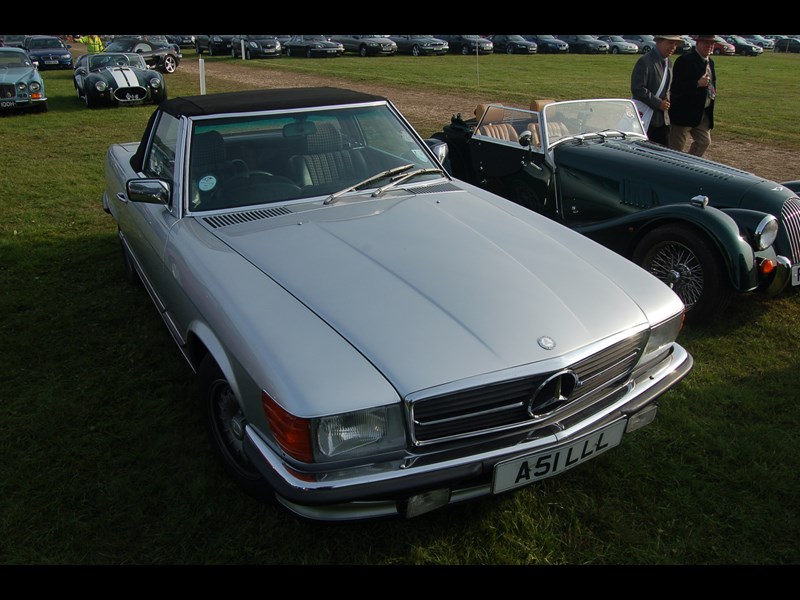
The R107-series SL was unveiled in 1971, presenting luxury-hungry buyers with stylish interiors, bigger engines and sharper, more contemporary bodywork. Mercedes-Benz’s renowned build quality quickly becomes apparent from the moment you close the door with a satisfying clunk. The 107 chassis was also an incredibly long-lived member of the Mercedes-Benz family, remaining in production until 1989. After four decades, the R107 SL is still a fashionable and popular vehicle, so prices have remained strong. Find a good example and you should have a surefire investment in the long term.
WHAT TO LOOK FOR
BODYWORK
Mercedes-Benz built these cars accurately, with very careful attention to how every item fitted in relation to another. Thus all external body sheet metal should fit precisely, with even gaps between any adjacent panels – the same goes for the bonnet and boot lid. Uneven gaps hint at removal, accident damage or worse.
Check where the wings are bolted to the inner aprons. Mercedes-Benz painted the cars after the front wings and doors were already attached, so all the bolts should be body-coloured and bonded with paint to the panels. If not, then this is a sure sign that repairs have been undertaken.
Post-1986 cars were the best rustproofed SLs, while pre-1976 versions – built before wax injection was introduced – are the most likely to suffer. Check for rust in the sills, box sections, jacking points and floors. Front and rear valances and wheelarches are also problem areas. Be sure to assess the windscreen – it’s bonded in – as well as checking rubber window seals for perishing. All panels apart from the front wings are welded on, and most are available from Mercedes-Benz. You can get pattern equivalents, but they often need extra fettling before they will fit satisfactorily. Accident damage is also a possibility, so carefully inspect the front chassis legs and inner panels to see if they’re rippled.
ENGINE & GEAROX
Engines should be capable of racking up 300,000 miles, and oil changes every 6000 miles will help prolong an engine’s lifetime. Also check whether regular coolant changes have taken place – it is vital that proper antifreeze with the correct inhibitors has been used, in order to guard against internal corrosion.
Blue smoke suggests worn valve stems, so changing them every 75,000 miles is recommended, along with the timing chain and tensioner. Keep an eye on the temperature gauge – if the radiator has become clogged up with silt then the V8s will run hot. Camshaft wear is another common issue on cars that haven’t been looked after properly, resulting in a clicking from the engine. If this has happened then the cam followers and possibly even the chain will have been affected, too.
Automatic gearboxes are the most common choice. Earlier cars have a fluid flywheel that can become temperamental when engaging first gear; from 1975 onwards, a torque converter was used instead. With all ‘boxes, check for excessive noise or difficulties when engaging gears. A vibration from the transmission indicates worn propshaft couplings. Replacement exhausts can be expensive, so look for bodged ‘dual’ systems – if there is no balance pipe between the front downpipes on V8s it will run rougher. Mercedes-Benz used a different firing order to most American cars and the balance pipe helps tuning as well as smooth running. Stainless systems last for much longer, but due to the lighter gauge metal they are usually a bit louder, so consider this before you buy.
SUSPENSION
Loose handling is usually down to tired shock absorbers, although bushes also deteriorate noticeably, especially on high-mileage cars. Worn subframe mountings can also seriously affect handling, especially on the more powerful V8 models. Steering dampers also deteriorate, as do power steering boxes, most commonly after 90,000 miles have been racked up. Beware of fitting aftermarket alloy wheels – they may look good, but bigger-than-standard items can really affect the feel of an SL and how it drives.
INTERIOR AND ELECTRICS
Four different trim options were offered over the years: leather, MB-tex, cloth or vinyl. Cloth is the least durable, followed by vinyl, leather and finally the über-resilient MB-tex. Seat covers in the latter are available quite reasonably, and even original pattern ones in leather are not too bad, so any typical tears or split seams in the driver’s seat need not be a deal-breaker. The hood should be a good quality padded one; while there are cheap vinyl replacements around, they look just that – cheap.
OUR VERDICT
If you’re after a stylish, sharp-suited roadster to potentially use all year round, then look no further. The R107 SL was improved continuously throughout its 18-year lifespan, with the result that the later the car, the better it is – run-out models from 1989 are most buyer’s top choices. SLs are rarely cheap to buy and the repair bills can be eye-watering, but they do make up for this by remaining a solid investment. The golden rule is to buy the best car you can afford. Happily though, once you’ve found the right car for you, R107s can be enjoyed in much the same way as a modern Mercedes-Benz, with all the reliability you’d expect in that regard but with infinitely more character and personality.











